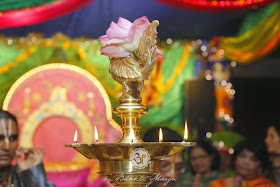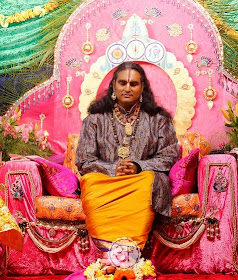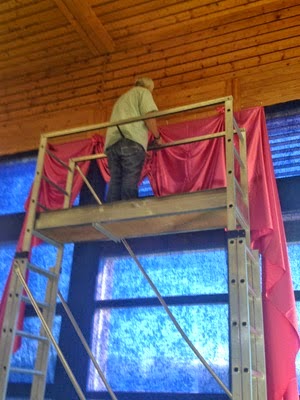For the first time in Bhakti Marga (BM) history, a night celebrating the Karthik month took place at Shree Peetha Nilaya, from 17:30 of 25th October till 6:30 of 26th October. This celebration took place one week after the BM Govinden Festival of Cudrefin in Switzerland. A whole night of singing the glories of the Lord and dancing around the Kuthu Vilakku (floor lamp), which according to Sri Swami Vishwananda represents the centre point of all, Bhagavan Krishna Himself, the Ultimate.
During his opening speech Sri Swami Vishwananda explained the meaning of the Karthik Night prayers and revealed the ‘whole set’ of four main BM celebrations during the 2014 Karthik month:
-Ras Karthik (8 October), which took place during the Inauguration of the BM Radha Krishna Bhakta Udara Temple in Leiria, Portugal and commemorated the Ras Leela of Lord Krishna.
-Damodara Karthik (18 October), which took place during the Govinden Festival and commemorated the Damodara Leela of Lord Krishna.
-Govardhan Karthik (15 October), which took place during the Karthik Night at Shree Peetha Nilaya, Springen, Germany.
Sri Swami Vishwananda said, “Today is when the Govardhana's puja is performed. Govardhana is the mountain which Lord Krishna lifted in his little finger to protect Vrindavan inhabitants from the wrath of Indra and to break the ego of Indra, revealing to Indra that he was just doing his duty. He is also reminding each person that when they have been given a certain duty in life, they have to happily do the duty which has been given to them. Then, the Lord reveals Himself.”
Sri Swami Vishwananda also added, “And next week it'll be Kalyana Utsavam which commemorates the marriage of Mahavishnu to Lakshmi and Bhu Devi. In the south India, they celebrate Vishnu Kalyana and in the north India they celebrate Tulsi Vivah, which is when Mahavishnu married Tulsi. And the end of Karthik is on the six of November.”
-Govardhan Karthik (15 October), which took place during the Karthik Night at Shree Peetha Nilaya, Springen, Germany.
Sri Swami Vishwananda said, “Today is when the Govardhana's puja is performed. Govardhana is the mountain which Lord Krishna lifted in his little finger to protect Vrindavan inhabitants from the wrath of Indra and to break the ego of Indra, revealing to Indra that he was just doing his duty. He is also reminding each person that when they have been given a certain duty in life, they have to happily do the duty which has been given to them. Then, the Lord reveals Himself.”
Sri Swami Vishwananda also added, “And next week it'll be Kalyana Utsavam which commemorates the marriage of Mahavishnu to Lakshmi and Bhu Devi. In the south India, they celebrate Vishnu Kalyana and in the north India they celebrate Tulsi Vivah, which is when Mahavishnu married Tulsi. And the end of Karthik is on the six of November.”
Ritual prayers during Karthik Night
 |
| Kalash Puja/Homa performed during Karthik Night |
The night celebrations started with Kalash puja and Abishekam performed by Sri Swami Vishwananda on a Govardhana shila, which is worshipped regularly at Shree Peetha Nilaya as Lord Krishna.
 |
| Sri Swami Vishwananda performs an Abishekam on a Govardhana shila |
Throughout
the night a puja was performed every three hours, and afterwards the
delicious prasad which had been offered to the deities was
distributed to everyone present.
 | ||||||||||||
| Prasad |
The sweetest moment of the Karthik night
 |
 |
| Abishekam performed on the Lotus Feet of Sri Swami Vishwananda during Karthik Night |
Overnight chanting the Glories of the Lord
The Damodarashtakam is a eight-verse prayer which is traditionally sung during the auspicious month of Kartik, also known as Damodara. Damodara is a name of Krishna which refers to His Leela when He let Himself to be bound by His mother Yashoda's affection.
The Gopi Gita was described by Sri Swami Vishwananda as the ‘longing song of the gopis’, the ‘expression of their longing for Krishna’.
The Kuthu Vilakku
 |
| Sri Swami Vishwananda lighting the the top part of the Kuthu Vilakku (5 oil lamp wicks) |
 |
| Matajis lighting the 150 oil lamp wicks as instructed by Sri Swami Vishwananda |
 |
| The Kuthu Vilakku with all 155 oil lamp wicks already lit. It consists of 30 lamps with 5 oil lamp wicks/each plus the top lamp with 5 oil lamp wicks. Sri Swami Vishwananda explained the meaning of the Kuthu Vilakku at Govinden Festival. |
 |
| The base of the Kuthu Vilakku is decorated with a colourful rangoli |
 |
| Throughout the night the Kuthu Vilakku had to be continuously looked after to make sure that there was enough oil and all the oil lamp wicks were lit. |
Overnight dancing around the Kuthu Vilakku
A opening night performance was presented by a group of 14 matajis from the Shree Peetha Nilaya community.
 |
| Opening night performance around the Kuthu Vilakku |
 |
| Overnight dancing around the Kuthu Vilakku |
Main differences between Govinden Festival and Karthik Night
“The Govinden Festival is traditionally from Mauritius, it doesn't even exist in India. It was celebrated for the first time, in the mid '50s, in Port Louis, the capital of Mauritius. It is especially dedicated to the eighth avatar of Mahavishnu, Lord Krishna, in His aspect of Govinda, which is related to the Govardhana Leela, when Lord Krishna lifted the mountain Govardhana with his little finger. This festival takes place over a period of four weeks, every Saturday from mid September till mid October. Each week the celebration is done in a different temple situated in a different part of Mauritius, to make it easily accessible to everyone.
On the other hand, the Karthik Night is celebrated from mid October until six of November. So this is the main difference between these two celebrations, Govinden Festival and Karthik Night.
However the Karthik Night as it is celebrated at Shree Peetha Nilaya was never done before. It's very special. In India there are special celebrations for Mahavishnu and Krishna during the Karthik month but people light clay lamps like during Diwali.
In some parts of India, the Kuthu Vilakku is used traditionally during Navaratri Celebrations and also for Mahavishnu prayers in some temples but not for Lord Krishna as it is used during the Mauritian Govinden Festival. There are also differences in the Kuthu Vilakku used in different celebrations. The Kuthu Vilakku used during Govinden Festival has a peacock on the top of the lamp, while the ones used for Divine Mother during Navaratri have a hamsa, a swan.



















































